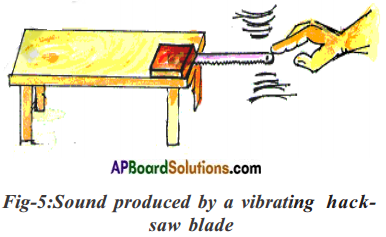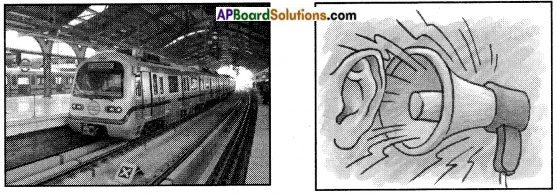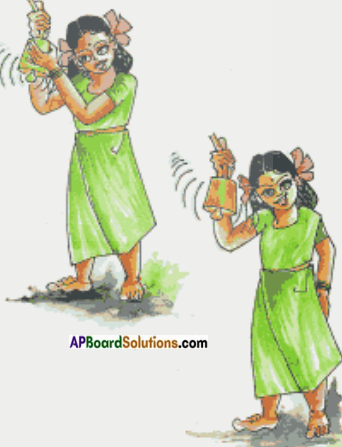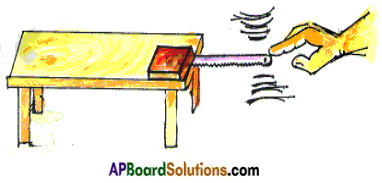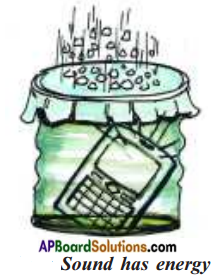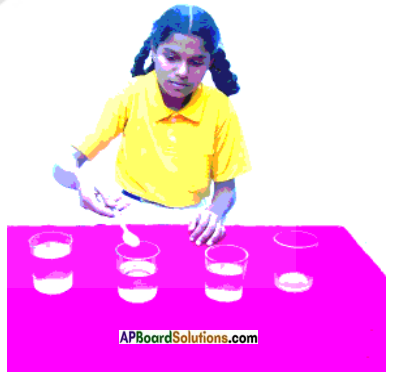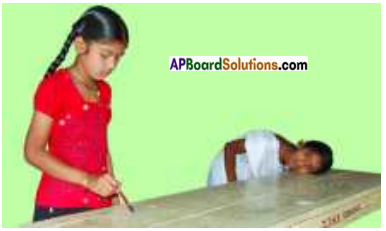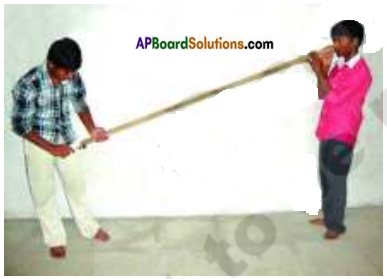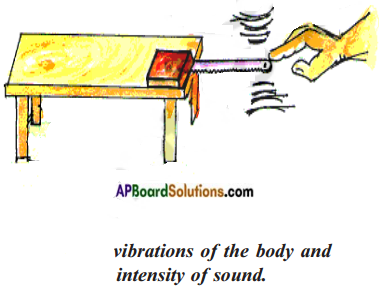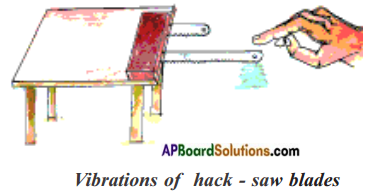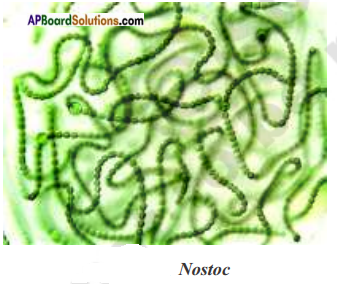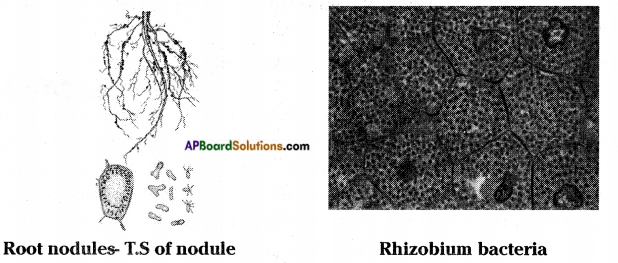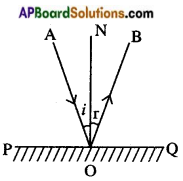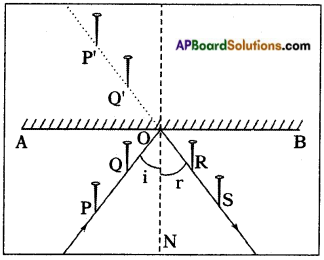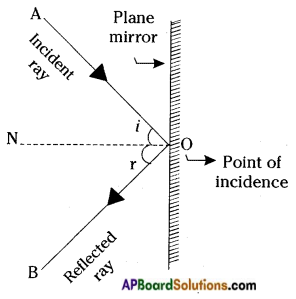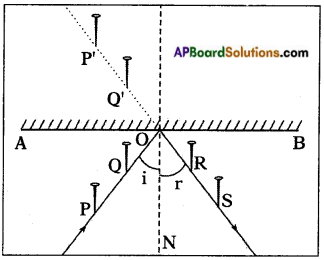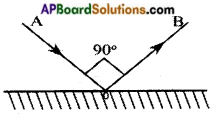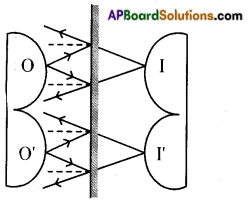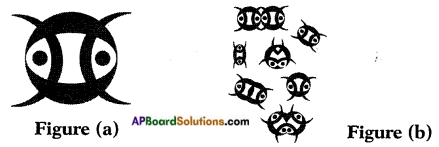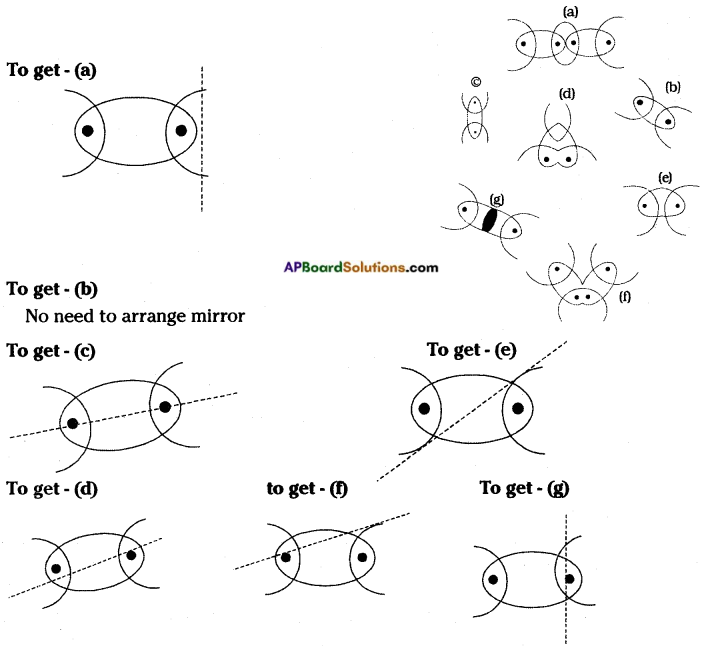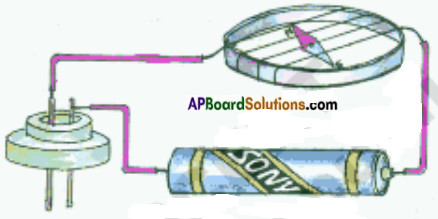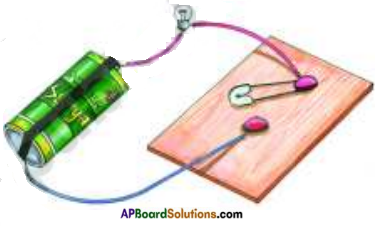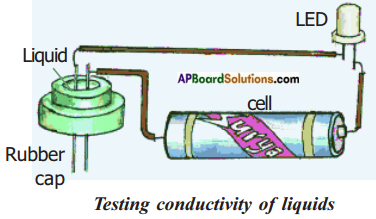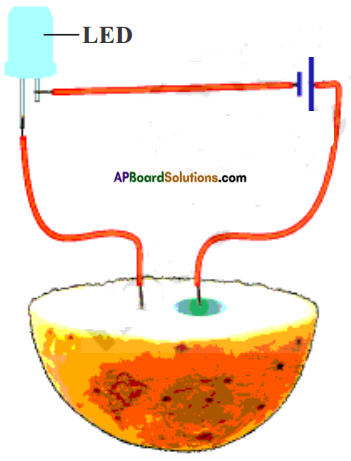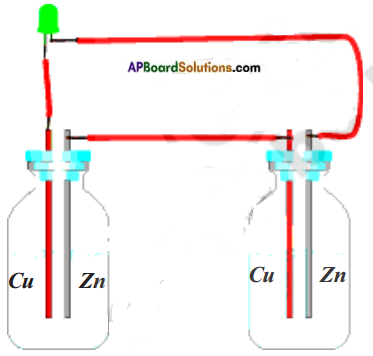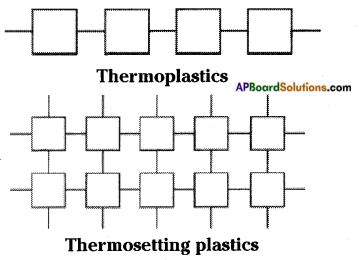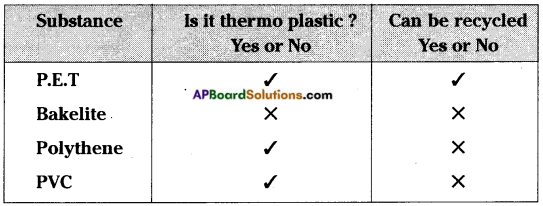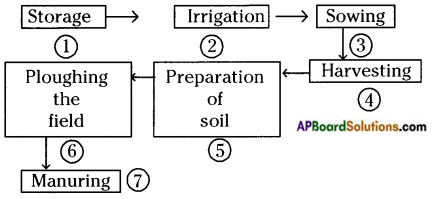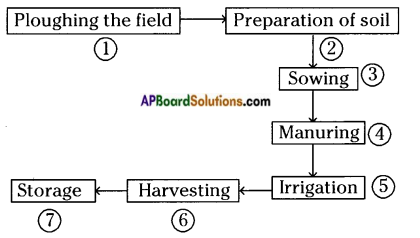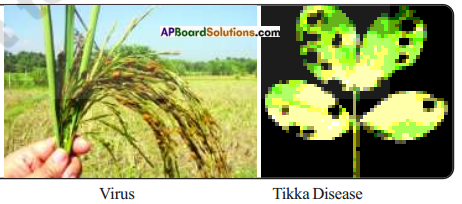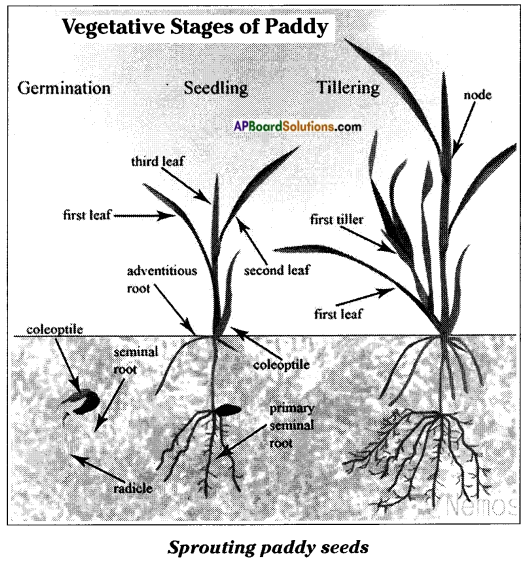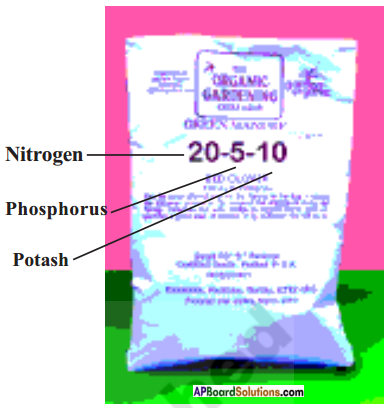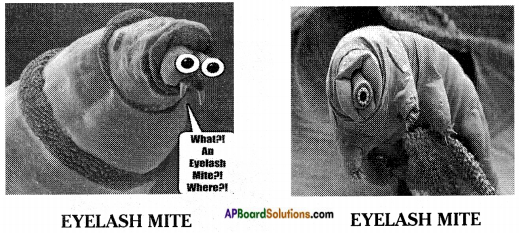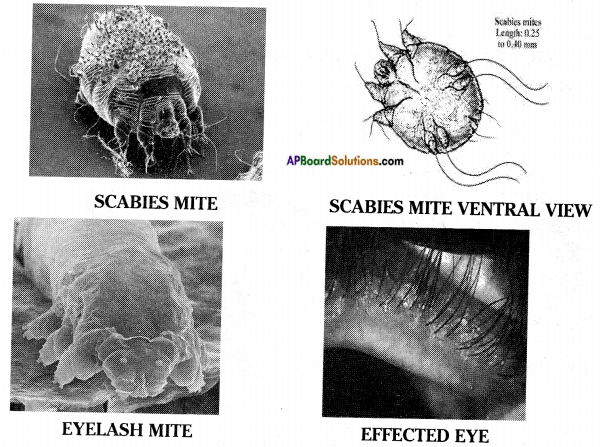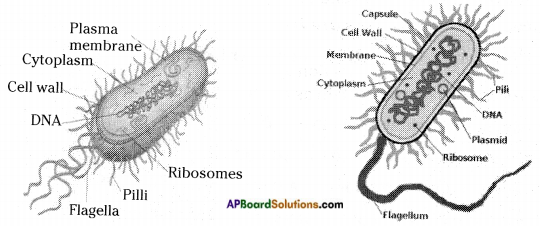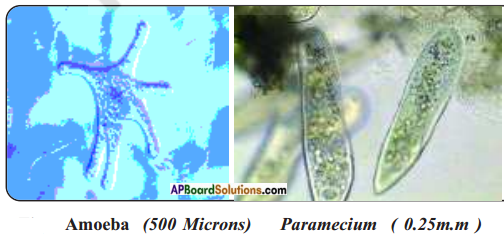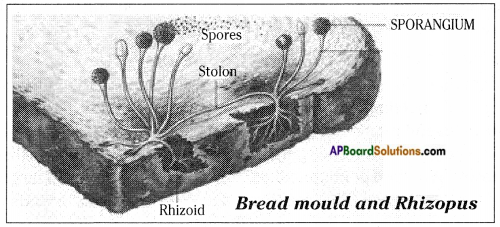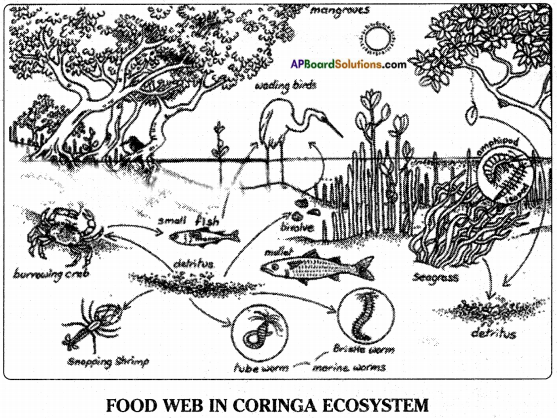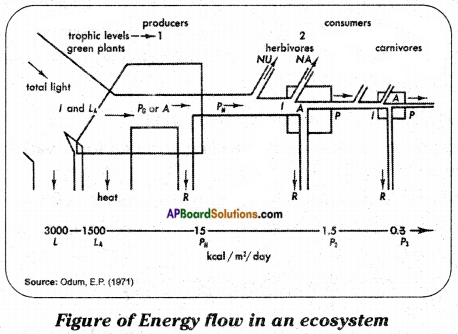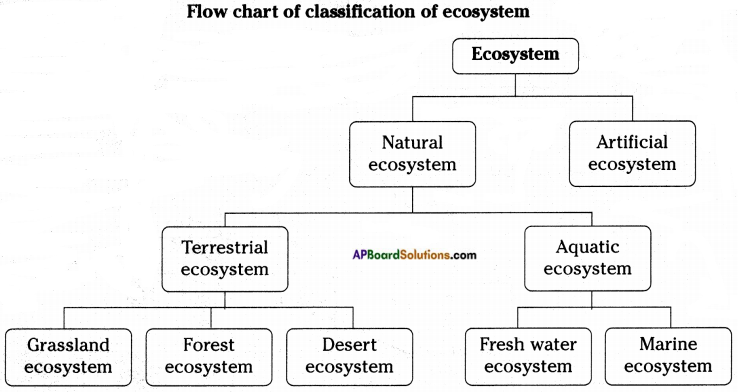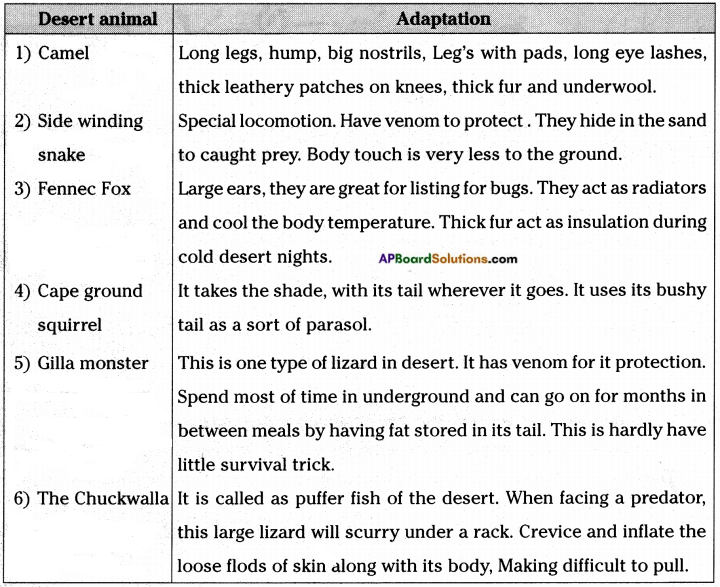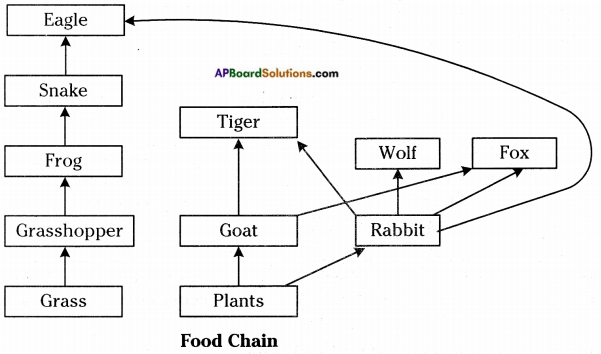AP State Syllabus AP Board 8th Class Physical Science Solutions Chapter 12 Stars and the Solar System Textbook Questions and Answers.
AP State Syllabus 8th Class Physical Science Solutions 12th Lesson Stars and the Solar System
8th Class Physical Science 12th Lesson Stars and the Solar System Textbook Questions and Answers
Improve Your Learning
Question 1.
What is your local noon time?
Answer:
The time when the shortest shadow of a vertical object occurs in a particular place is called local noon time at that place.
Question 2.
Where do you find moon at night?
a) 2 days before Poumami
b) 2 days after Amavasya
Answer:
a) Couple of days (2 days) before full moon day (Pournami), a crescent is seen in the west just after sunset.
b) Couple of days (2 days) after the new moon day (Amavasya), a crescent is seen in the west just after sunset.

Question 3.
Why doesn’t eclipse occur on every full moon day or on every new moon day?
Answer:
Lunar eclipse can happen during a full moon and only when the moon and earth and sun are directly in line and the moon passes through the earth shadow. Most of the time the moon is slightly out of line and that is why we don’t have a Lunar eclipse every full moon.
Question 4.
Where do you find the pole star?
Answer:
The pole star lies on the line joining the two outer stars of the constellation great bear. Pole star directly above the north pole of earth.
Question 5.
What Is the difference that you find between pole star and other stars?
Answer:
If we observe the position of various stars constantly. We will notice that they are not in a fixed position because as the earth rotates about a fixed axis, the position of stars with respect to earth changes. But the position of pole star does not change with respect to earth.
Question 6.
Why does polestar seem to be stationary?
Answer:
The polestar is situated in the direction of the earth’s axis and that is why it does not appear to move even though all stars appear that they are moving because of ie rotation of earth. So pole star seems to be stationary.
Question 7.
Name some constellations.
Answer:
Names of some constellations:
- Great bear (Saptarishi)
- Cassiopeia (Sharmistha)
- Orion
- Leo (Simha)
- Corona
- Borealis

Question 8.
How many planets are there in our solar system? What are they?
Answer:
There are 8 planets in our solar system. They are:
- Mercury
- Venus
- Earth
- Mars
- Jupiter
- Saturn
- Uranus and
- Neptune.
Question 9.
Look at the below table and name the smallest and the biggest planets in our solar system.
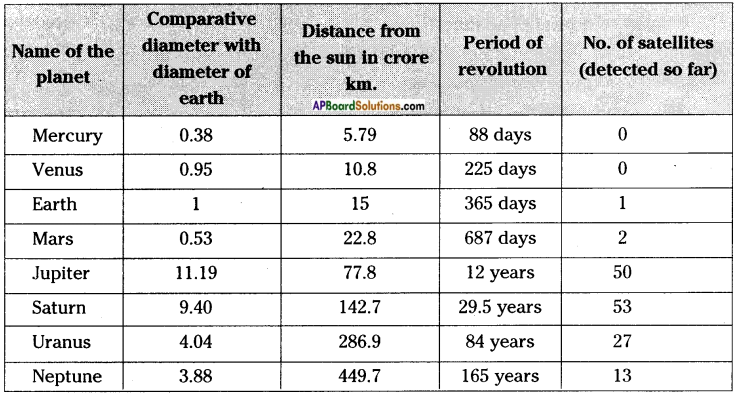
Answer:
From the table the biggest planet is Jupiter and the smallest planet is Mercury.
Question 10.
Among all 8 planets what is the special thing about earth?
Answer:
The special thing about earth is it is the only planet in the solar system on which life is exist.

Question 11.
How do day and night occur?
Answer:
The day and night occur due to rotatory motion of earth.
Question 12.
Do the stars appear moving? How can you say?
Answer:
Yes, stars are appear moving. Our galaxy like all other spiral galaxies is rotating. The stars move on orbits around the centre of the galaxy. It was the motions of stars in external galaxies that lead to the idea of dark matter in the universe. Stars also have some random motions. They do not orbit galaxy in exact circles. As observers we see this motion of the stars as what is called proper motion, the projection of their velocity on to the plane of the sky is radial motion.
Normal Answer : Alternate answer is No. All the stars appears that they are moving because of rotation of earth.
Question 13.
Is it possible to see the polestar for the people who live in the southern hemisphere of the earth? Why?
Answer:
A pole star is a visible, preferably a prominent one, that is approximately aligned with the earth’s axis of rotation. The term polestar refers to polaris which is the current northern pole star also known as the north star. So the people in southern hemisphere unable to see this pole star.
Question 14.
What is the use of artificial satellites in our daily life?
Answer:
Artificial satellites have many uses in daily life.
- They are used for forecasting weather.
- They are used for transmitting television and. radio signals.
- They are also used for telecommunication.
- They are used in aviation and military (these satellites are called remote sensing which will collect information from a distance).
Question 15.
Why is Venus the brightest planet?
Answer:
Venus is very bright that’s partly because sunlight easily reflected by acidic clouds that blanket the planet atmosphere and also it is closest planet to earth.

Question 16.
Are you curious about going to the moon? Why?
Answer:
Yes, I am curious about going to moon. Because I want to find answers raised in my mind.
- Is it true there is no life on moon?
- If it does not have atmosphere, how it look like?
- How earth look like from moon?
- Whether there are any mountains on moon or not?
- There may be any creators on moon or not?
- Whether there is any form of water exists on moon?
- Whether we able to walk on moon as freely as on earth surface?
Question 17.
While observing the shadow of a stick from morning to evening, some questions arose in Ramya’s mind. What may be those questions?
Answer:
- Why sun is changing its position from morning to evening?
- How does the length of the shadow change with time?
- Why we are getting longest shadows in the morning and evening?
- Why the shadow in the noon is shortest?
- Do all the days at noon have same size of shadow?
Question 18.
What are the questions that engage your mind when you look at night sky?
Answer:
- Is stars collide with each other?
- Where does the stars go in the morning?
- Whether stars daily travel in the same path?
- Why night sky is black and early morning sky is blue?
- Whether we can count stars in the sky?
- Why stars grouped to form constellations?

Question 19.
Even though we do not have clock, we can know the time by observing some shadows in daytime. Think and discuss with your friends how we can know the time at night?
Answer:
We can know the time by position of moon and stars or with reference to pole star. Estimation of time by using position of moon:
- If the moon is full do the experiment stop if it is new moon.
- Imagine the moon is divided into 12 vertical strips. First hour at right edge and last hour at left edge. It can vary by season or location.
- Read the moon from left to right following an imaginary horizontal half line.
Look for where the line intersects the boarder between light and dark. Make a note of which strip that intersection is in.
For example:
The instruction is at 8 pm and transition from right to left is from light to dark. This tells us the moon will set in the west at 8 pm.
This moon will set at about 7-8 hours after sunset. If sunset is at 8 pm. You can expect moon time is at 3-4 am.
Question 20.
How can you find north – south direction at your place?
Answer:
This experiment should be performed on a day when the sky is clear, preferably between nine in the morning and four in the evening.
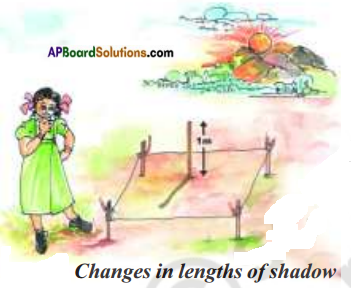
Pick a spot in open ground away from buildings and trees. The spot should be as flat as possible.
Take a stick which is a little over a meter long and fix it vertically in the ground. Ensure that exactly one meter of stick remains above the surface of ground. Build a fence around your stick as shown in figure.
Make your first observation at nine in the morning, Make a mark with a nail or peg at the point where the tip of the shadow falls on ground. Measure the length of the shadow.
Then, make similar observations for every half an hour throughout the day till four in the evening.
Find the direction of shortest shadow cast by vertical object on the ground. That gives the north-south direction.

Question 21.
In which direction (towards north or south) is the sun moving day by day when you read this lesson?
Answer:
From December 21 to till June 21 the sun appears to shift northward. From June 21 to December 21 the sun appears to shift southward.
(Basing on this information we have to give the answer suppose you have read the lesson in the month of February the sun is moving towards north direction).
Question 22.
What are the planets you have seen in the sky? When do you observe those planets?
Answer:
The two planets observe in the sky are
- Venus: Sometimes Venus appears in the eastern sky before sunrise. Sometimes it appears in the western sky just after sunset. Therefore it is often called a morning or an evening star.
- Mars: It appears slightly reddish and therefore, it is also called red planet. It appears in the east.
Question 23.
What is the duration of a day and night today? Collect the information about duration of day and night for the past 7 days from the newspapers, analyze it and say whether summer or winter is going to come.
Answer:
Students have to collect the information from newspaper and other resources.
(Hint: If sun is shifting towards south the upcoming season is winter if it is shifting towards north the upcoming season is summer).
Question 24.
What are the other districts on the same latitude as your district ?
Answer:
I am residing at Krishna district. The latitudes of Krishna district are 16. The other districts which have same latitude are West Godavari, Mahaboobnagar.
(You should write the latitude of your district and you have to find out the districts which lie in that latitude from table -1 on page 163 of textbook.)

Question 25.
Collect the information about cosmic dust (wastage) from newspapers, internet and make a poster on your school panel board about the consequences of cosmic dust.
Answer:
Cosmic dust: Cosmic dust is a type of dust composed of particles in space which are a few molecules to 0.1 mm in size.
Consequence of cosmic dust:
The orbit of space junk could deteriate resulting in the junk falling to earth. If it survives and reaches the earth’s surface it would cause the same damage as equally sized meteorite, including damaging or destroying structures in the area killing people, etc.
The earth receives hundreds of tonnes of space dust, rocks, etc every week. If you were to get whole load of it in one place and try and breathe it in it probably would be harmful. However natural concentrations are so low that it possess no risk.
Question 26.
Make a sundial. Explain how you made it.
Answer:
Making of sundial:
Cut a right angled triangle ABC from a sheet of cardboard. Angle C of the triangle should equal to the latitude of your city or town and angle A should be 90° as shown in figure.
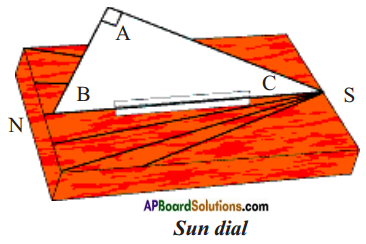
Fix cardboard triangle vertically in the middle of a rectangular wooden board. Glue strips of paper along both edges of BC and the wooden board to make the triangle stand erect.
Place your board with the triangle on level ground in an open space which gets sunlight throughout the day. Base BC of the triangle should be placed in the north- south direction, with B pointing to the north.
At nine in the morning, draw a line along the shadow of side AC on the wooden board. Write the time along side of the line. Draw lines of the shadow of side AC at one hour intervals through the day till sunset and mark the time for each line. The sundial is now ready.

Question 27.
Draw the different phases of moon. Arrange them in an order from poumami to amavasya.
Answer:
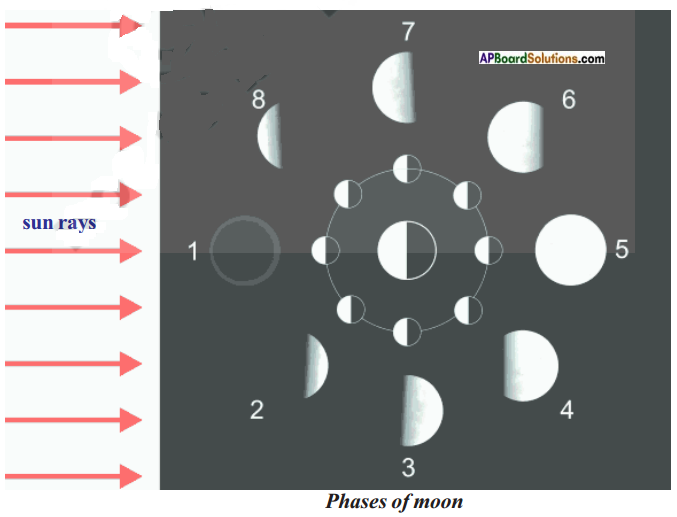
Question 28.
Draw the location of polestar showing the direction from Great Bear.
Answer:


Question 29.
Draw the diagram of the solar system.
Answer:
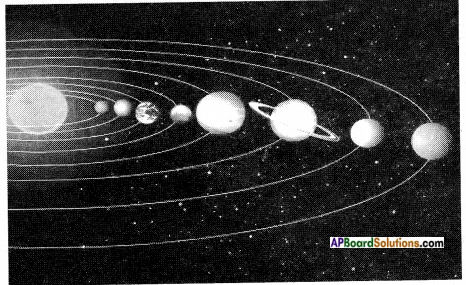
Question 30.
How do you appreciate the construction of knowledge about the universe by our ancestors?
Answer:
They study of our universe changed from time to time from earth is flat to higgs bosan particles. All these secrets about our universe are revealed due to constant afforts of our ancestors. That is due to construction of knowledge about the universe by our ancestors. So the afforts of our ancestors should be thoroughly appreciated.
Question 31.
We launched so many artificial satellites around our earth for different purposes. What do you think about the impact of artificial satellites and their radiation on bio-diversity?
Answer:
Effect of radiation released from artificial satellites on biodiversity:
I. Animals and humans:
- Killing certain enzymes in the body can simply make sick.
- If radiation damages DNA, the body may not repair it. It increases the chances of both animals and humans developing cancer.
II. Marine animals: High level of radiation cause a reduction and reproduction capabilities of marine animals.
III. Plants: Weaking of seeds and frequent mutations. Excess of radiation killing plants.

Question 32.
Among eight planets of our solar system, earth is the only planet supporting life. Explain how we should protect our earth and its environment.
Answer:
Steps to be taken to protect earth and environment:
- Reduce pollution by reducing air, water and land pollution.
- Recycle resources by sending the degradable like paper and non degradable like plastic and glass objects to recycling factory.
- Save resources by using them carefully. E.g.: Water, trees, wood, paper.
- Stop burning fossil fuels (Coal, oil and natural gas) for that do not waste electricity.
- Plant lot of trees.
8th Class Physical Science 12th Lesson Stars and the Solar System InText Questions and Answers
8th Class Physical Science Textbook Page No. 160
Question 1.
What are the celestial objects that we can see in the sky?
Answer:
Stars, Planets, Moon (Satellite), Comets, Meteors and Meteorites are the celestial objects that we can see in the sky.
Question 2.
Are the stars moving?
Answer:
Yes, the stars are moving.
Question 3.
Do you see the same stars at night and early in the morning?
Answer:
No, we do not see the same stars at night and early in the morning.
Question 4.
Do you see the same stars during summer and winter nights?
Answer:
Yes, it is due to the change of axis of rotation of the earth.
Question 5.
What is the shape of the moon? Why does it change? Why doesn’t the sun change its shape daily like the moon?
Answer:
The actual shape of the moon is approximately spherical.
But it changes everyday.
The sun does not change its shape like the moon due to its size and the distance it is away from the earth. Moreover the shadow of the earth falls on one side of the moon partially or fully. This makes the changes in its shape. Also the moon does not have its own light to make the shadow of the earth to fall on the huge sun.
Question 6.
Where exactly is the sun situated in the sky at noon?
Answer:
Above our head (vertically above) (Really the sun does not revolve around the earth but due to the rotation and revolution of the earth we feel / imagine that the sun moves around the earth.)

Question 7.
Why does the shadow of a tree change from morning to evening?
Answer:
Due to the rotation of the earth we find the sun at different positions in the sky which brings the tree the different shadows from morning to evening.
8th Class Physical Science Textbook Page No. 168
Question 8.
Will we be able to hear any sound if we were on the moon? Why?
Answer:
Sound required a medium for its propagation. There is no atmosphere (medium) on moon. We know sound cannot travel in vacuum. So we unable to hear any sound if we were on the moon.
Question 9.
Can any life exists on the moon? Why?
Answer:
Moon does not have air (oxygen) and water which are essential for existence of life. So there is no life exists on moon.
8th Class Physical Science Textbook Page No. 169
Question 10.
Why does lunar eclipse occur only on a full moon day?
Answer:
Lunar eclipse occur only on a full moon day because lunar eclipse happen when the earth’s shadow falls on the moon, hiding it from the sun’s light. For this to happen, the moon must be on the opposite side of the earth from the sun. So the full half of the moon that is lit by the sun is visible from earth that is full moon day.
Think and Discuss
8th Class Physical Science Textbook Page No. 161
Question 1.
Look at the nails or pegs you have fixed on the ground to keep track of the shadow of the stick throughout the day. From their positions, can you tell how the position of the sun changes in the sky from sunrise to sunset?
Answer:
The position of sun changes from slanting to vertical and then vertical to slanting.
8th Class Physical Science Textbook Page No. 163
Question 2.
Why does the sun appears to travel towards north or south? Try to find the answer by reading your social studies chapter “Earth movements anti seasons” along with this lesson.
Answer:
The earth’s tilt is constant 23.5 degree perpendicular. The earth position relative to sun changes, not the tilt itself during orbit. The sun is moving towards north throughout summer because the north pole is tilted 23.5 degree towards sun and we are in northern hemisphere. During the winter the south pole is tilted 23.5 degree so the sun appear to travel towards south.
8th Class Physical Science Textbook Page No. 168

Question 3.
Scientists are planning to build settlements on moon and are trying to make arrangements to live there. You know that there is no air on moon. How will it be possible to live on the moon then?
Answer:
Oxygen is essential for humans. Unless we built special structures and buildings on the moon and put oxygen into them, we would not able to live on the moon without wearing oxygen tanks all the time.
8th Class Physical Science Textbook Page No. 178
Question 4.
The diameter of the sun is 13,92,000 Km. The diameter of the earth is 12,756 Km. The diameter of the moon is 3,474 Km. The distance from the sun to earth is 15,00,00,000 Km. The distance from the earth to moon is 3,84,399 Km.
Take the scale as 1 lakh km = 1 cm, and imagine how the arrangement of sun, earth and moon is in our universe. Can you make this arrangement on your school ground?
Answer:
Yes, we can do it in our play ground. Placing sun at the middle. Rotating earth around sun and rotating moon around earth by measuring diameters in cm.
8th Class Physical Science 12th Lesson Stars and the Solar System Activities
Activity – 1
Question 1.
Observing the changes in the length of shadow.
This experiment should be performed on a day when the sky is clear, preferably between nine in the morning and four in the evening.

Pick a spot in the open ground away from trees and buildings.
The spot should be as flat as possible. Take a stick which is a little over a meter long and fix it vertically in the ground. Ensure that exactly one meter of stick remains above the surface of ground.
Make your first observation at nine in the morning. Make a mark with a nail or peg at the point where the tip of the shadow falls on ground. Measure the length of the shadow.
Then, make similar observations for every half an hour throughout the day till four in the evening.
Use a clock to fix the time for making your observations. Enter the measurements of the length of the shadow and the time of measurement in a table making two columns, one for time and another for length of shadow.
| Time | Length of the shadow |
| 9.00 am | 1.75 m |
| 9.30 am | 1.7 m |
| 10.00 am | 1.6 m |
| 10.30 am | 1.5 m |
| 11.00 am | 1.1 m |
| 11.30 am | 0.8 m |
| 12.00 noon | 0.7 m |
| 12.30 pm | 0.81 m |
| 1 pm | 1.12 m |
| 1.30 pm | 1.3 m |
| 2.00 pm | 1.5 m |
| 2.30 pm | 1.75 m |
| 3.00 pm | 1.84 m |
| 3.30 pm | 2.2 m |
| 4.00 pm | 2.5 m |
(These values are changes from place to place and with seasons)
a) Look at your table and figure out the time of the day of shortest shadow.
Answer:
I observed at 12 noon.
b) When did you observe the longest shadow in your activity?
Answer:
At 4 pm.
c) How does the length of the shadow change with time? Illustrate your answer with the help of some diagrams. Draw the diagrams of the stick and its shadow for 5 different times, that is, at 9am, 1 lam, 12noon, 2pm and 4pm.
Answer:
The size of the shadow decreases and reach a minimum and then increases (It has minimum value at 12 noon)
(Students have to draw the diagrams of the stick and its shadow at 9 am, 11 am, 12 noon, 2 pm and 4 pm by doing this activity)

d) If you continue your activity from sunrise to sunset, at what times do you think the shadow would be the longest?
Answer:
At sunrise and at sunset.
e) Where is the sun situated in the sky at noon? Where does the shadow of stick is fall at that time? Think about how your own shadow will be at that time.
Answer:
Almost in line with the stick. It will falls in north-south direction. My own shadow is also in north-south direction.
f) Do you think that your shadow length will be the same on all the days at noon?
Answer:
Yes, the shadow will be same on all the days (with in two weeks).
g) In which direction does the shortest shadow of the stick fall in your activity?
Answer:
The shortest shadow falls in the north-south direction.
Continue your observations.
h) Observe on the next day whether the shadow of the stick falls at the same spots at the same times throughout the day.
Answer:
Yes, it falls on the same spot.
i) Can you use your stick as a clock (sundial) to tell the time? If your answer is ‘yes’, explain how this is possible.
Answer:
Yes, due to movement of sun from east to west.
j) Two weeks later, once again check to see whether the stick’s shadow falls at the same spots at the same times during the day.
Answer:
It fall on the same spot. But length of shadow change.
k) If the shadow does not fall on the same spot, what could be the possible reason?
Answer:
The position of the sun in the sky changes during the day.
l) If you continue the experiment the position of shadow changes or not ?
Answer:
No, it does not change. The position of sun changes from day to day as well.
That is, the position of the sun at 10.00 am today will be different from its position two weeks later at the same time. If you choose a particular time every week and mark the position of the sun with a peg at that time, you can build a calendar for the full year.
m) During a period of two weeks you had made an observation that the length of the shadow at a particular time is changing day by day. Did it become longer or shorter?
Answer:
Yes, it is changing day by day. During summer it is shorter day by day and during winter it is larger day by day.
n) By observing the direction of shadows, can you guess the arrival of summer or winter?
Answer:
Yes.

Activity – 2
Question 2.
Understanding the north-south movement of the sun.
Fix a spot near your home from where you can observe the sunrise. You may have to go to the terrace of a RCC building or go to an open field for the purpose. Choose a tree or an electric pole or some other stationary object as a reference point.

Over the next 10 to 15 days, note the spot at which the sun rises daily, keeping in mind your reference point. Make a daily sketch of the rising sun as well as your reference point in your notebook during this period.
a) Does the spot of sunrise change? If it does, in which direction does it seem to move?
Answer:
It may moves towards south of the sky if it is Dakshinayanam or it may moves towards north of the sky if it is Uttarayanam.
(So answer based upon Uttarayanam or Dakshinayanam)
b) Was the sun appear travelling towards south or north during the time you made your observations?
Answer:
It is travelling towards north.
c) Do you think that is the reason for the change in the length of the shadow of the stick day by day in activity 1 ?
Answer:
Yes, that is the reason.
d) Assuming that you did not have any calendar and knowledge of months and seasons, can you use movement of the sun to predict the arrival of winter or summer?
Answer:
Yes, if it is moving towards north, the coming season is summer (in the above case it is summer) and if it is moving towards south, the coming season is winter.
Activity – 3
Question 3.
Make your own sundial.
Answer:
First of all, you will need to cut a right angled triangle ABC from a sheet of cardboard. Angle C of the triangle should equal to the latitude of your city or town and angle A should be 90° as shown in figure.

A list of latitudes of districts of Andhra Pradesh is given below in table.
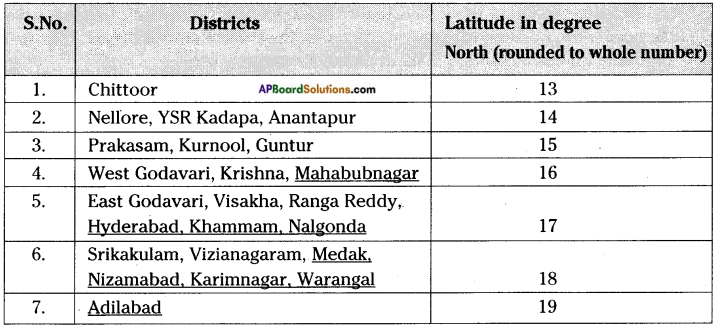
Fix your cardboard triangle vertically in the middle of a rectangular wooden board. Glue strips of paper along both edges of BC and the wooden board to make the triangle stand erect.
Place your board with the triangle on level ground in an open space which gets sunlight throughout the day. Base BC of the triangle should be placed in the north- south direction, with B pointing to the north.
At nine in the morning, draw a line along the shadow of side AC on the wooden board. Write the time along side the line. Draw lines of the shadow of side AC at one hour intervals (use a clock to check the time) through the day till sunset and mark the time for each line. Your sun-dial is ready.

Activity – 4
Question 4.
Observing phases of the moon.
a) Have you ever observed the movement of moon in the sky?
Answer:
Yes.
b) Does the moon appear at same point at a particular time everyday?
Answer:
Yes.
c) s the shape of the moon same on everyday?
Answer:
No, it changes.
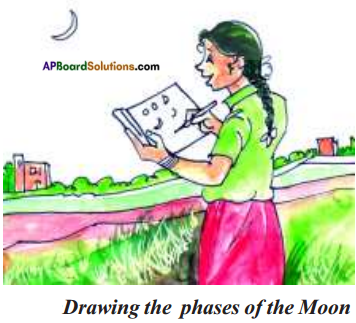
Now note the date of the day after new moon day (amavasya), when the moon first appears in the sky.
Also note the time at night when the moon sets (goes down in the western sky). In the same way everyday locate the moon in the sky at the time of sunset or immediately after sunset.
Record the date and time of the moon set and draw a picture of the moon as you see it on that day in your notebook as shown in figure.
Continue making observations for as many nights as possible.
Observe the moon a few days before full moon day (Pournami) to a few days after it. Locate the position of moon in the sky at the time of sunset before Pournami and note the time and position of moon in the sky at that time.
After Pournami, note the time at which the moon rises (comes in the eastern sky) and also note the date. Draw pictures of the shape of the moon each of these days.
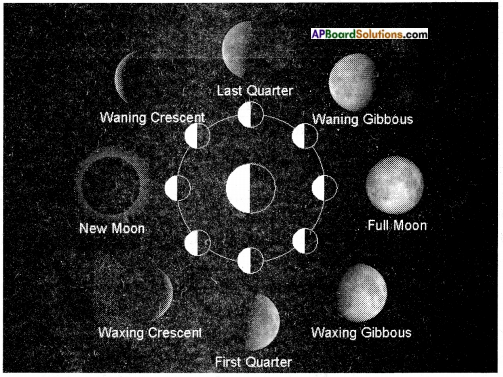
d) Can you calculate the number of hours between one moon rise and the next moon rise or the number of hours between one moon setting and the next moon setting, with help of these observations?
Answer:
It is about 24 hours and 50 minutes.

e) How many hours lapse between one sunrise to the next, or one sunset to the next?
Answer:
It is about 24 hours.
f) Is the time period same for sun and moon to appear at selected position after completing a cycle in the sky every day?
Answer:
No, they are different.
g) Does the moon appear at the same point every day during the time of the sunset?
Answer:
No.
h) What is the shape of the moon? Is it same every day?
Answer:
It is changing day by day.
i) You might have observed that the shape of the moon changes night after night. What is the name given to these changes in appearance ?
Answer:
These changes in its appearance are called the phases of the moon.
j) Can you guess why the shape of the moon changes?
Answer:
The time period taken by sun to complete a cycle in the sky and come to the selected position is almost same everyday and it is about 24 hours i.e., 1 day. Whereas moon takes about 50 minutes more than a day to complete the cycle and which results in the phases of moon.
Activity – 5
Question 5.
A Moon-shaped lemon.
Answer:
Choose a day one week after the new moon day when the moon is visible in the sky during the day time.
Take a yellow lemon or a whitewashed clay ball and pivot it on a long needle or on a spoke of bicycle. Hold it up towards the moon as shown in figure.
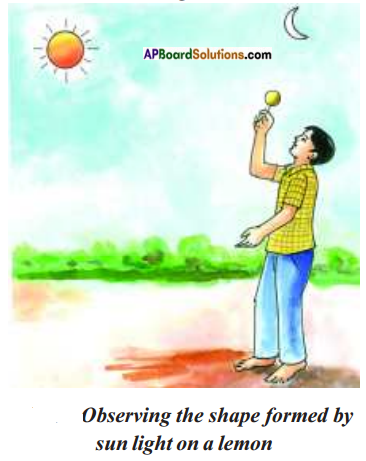
Ensure that you are standing in the sun¬shine when you do this activity.
Observe the shape formed by the sunlight on the surface of the lemon. Is there some similarity between the shape formed and the shape of the moon?
It forms one of the phase of moon.

Activity – 6
Question 6.
Why does the shape of the moon change ?
(Do this activity around 4p.m.)
Wrap a ball tightly with a white hand-kerchief or with a piece of white cloth.
Assume this is the moon. Hold this ball in front of your eyes in bright sunshine as shown in figure and turn around yourself slowly. Observe how the shape of the illuminated part of the ball changes.

a) Does sunlight fall on half the ball at all times while you turn around?
Answer:
Yes.
b) Is the shape of the illuminated part on the ball viewed by you same in all positions during your rotation?
Answer:
No, they are different.
c) Why does this happen?
Answer:
To understand this look at figure.
c) Why does this happen?
Answer:
To understand this look at figure.
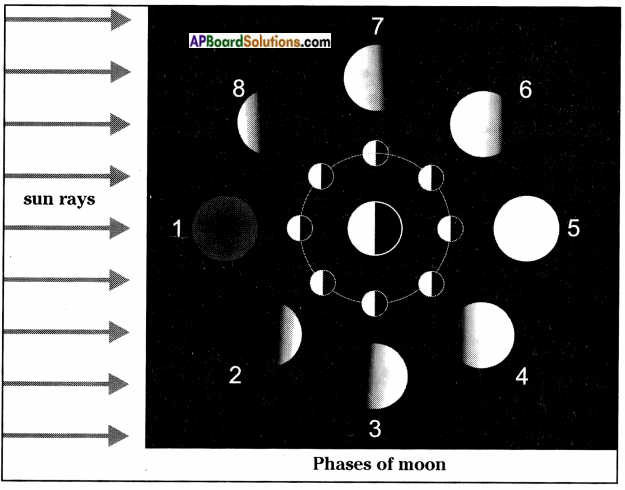
The large circle in the middle of figure is the earth and the smaller circles around it represent the moon in different positions. We can see the phases of the moon on different days in the figure. The sunrays falling on the moon illuminate half its surface in all the positions. However, we cannot see the entire illuminated surface in all the positions. In some cases we see the entire illuminated surface while in others we see only part of it. In one particular position, we cannot see the illuminated surface at all.
The shape of the moon we see is the shape of the illuminated portion visible to us.
In figure, the day of the new moon is called day 0 or day 28 (position 1). In this position, the illuminated surface is not visible from earth, so the moon cannot be seen from earth.
Four days later, when the moon is in position 2, a small part of its illuminated surface is not visible from earth. On day-7, the moon is in position 3, so more of its illuminated part is visible from earth.
After fourteen days (at position 5) the entire illuminated surface of the moon is visible from earth. This is the day of the full moon.
Subsequently, the moon appears smaller with each day as it passes through positions 6 (day-18), 7(day-21) and 8(day- 25). After 28 days, the moon is once again in position 1.
Try to duplicate position 1 with the ball. For this, you will have to hold the ball towards the sun (between your eyesight and the sun).

d) In this position, which half of the ball is illuminated?
Answer: Although half the surface of the moon is illuminated everyday, we cannot see the moon on new moon day since the illuminated surface is on the side opposite to the point of observation on the earth. On a full moon day, the situation is reversed. The illuminated half of the moon faces the point of observation, so we see a full moon.
e) Where is the position of sun and moon on new moon day and full moon day?
Answer:
The sun and moon must be on the same side of the earth on a new moon day and they are on opposite sides of the earth on a full moon day.
f) Can you now state as to in which direction the moon will rise on a full moon day?
Answer:
The moon will rise from west on full moon day.
While we observe moon in clear sky on a full moon day, we think about the spots those are visible on the moon. In olden days people are curious about the spots. This led to creation of a lot of stories.
e) Do you know any such story?
Answer:
One popular story to account for the dark spot on the moon is that Ganesha, once filled with food, fell from his mouse and broke his stomache. Chandra laughed at this, at which Ganesha injured him by breaking off and throughing one of his tusks and cursed him.
Activity – 7
Question 7.
Observing the movement of constellations (stars).
Take a 20cm x 20cm square sheet of paper and make a 1cm diameter hole in its center. Mark a cross ( X ) on one side of the sheet of paper as shown in figure.
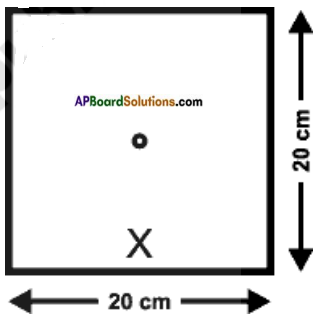
Hold the sheet in front of your eyes with the ‘X’ mark at the bottom and look for the pole star through the hole. Once you have located the pole star, check in which direction the Great Bear and Cassiopeia lie.
Write ‘G’ for Great Bear and ‘C’ for Cassiopeia on the paper in the directions in which you see each of the constellations. Mark the timing at which you made your observation in both cases.
Choose a nearby tree or house as a reference point. Draw a picture of your reference point on the paper sheet taken, clearly indicating its location. Repeat your observations at one hour intervals. Ensure that you are standing on the same spot each time you look at the stars.
Write G, C in the direction of the position of the great bear and Cassiopeia during each observation and note the time of the observation next to the letters G and C.
Using the tree or house you have chosen as your reference point, check whether the position of the pole star has changed or not. If it has changed, note the changed position.
Repeat this activity as many times as possible, the minimum being four times. But ensure that the ‘X! mark on your sheet of paper remains at the bottom during all your observations.

a) Do the positions of the stars change with time?
Answer:
Yes, they will change.
b) Does the position of the pole star also change with time?
Answer:
No, it will not change with time.
c) Does the shape of the great bear and Cassiopeia change with time or does the position of the entire constellations in the sky change?
Answer:
The position of entire constellation changes.
d) What kind of path do these constellations trace in the sky?
Answer:
They traced in northern sky.
Activity – 8
Question 8.
Why does the pole star appears fixed at one point?
Take an umbrella and open it. Make about 10-15 stars out of white paper. Paste one star at the position of the central rod of the umbrella and others at different places on the cloth near the end of each spoke.
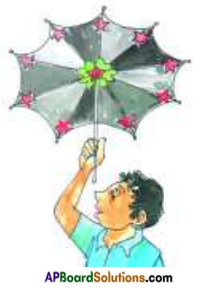
Now rotate the umbrella by holding its central rod in your hand. Observe the stars on the umbrella.
a) Is there any star which does not appear moving? Where is this star located? Is it located where the rod of the umbrella holds the cloth of the umbrella?
Answer:
Yes, it is located where the rod of the umbrella holds the cloth of the umbrella.

b) On similar lines, if there were a star located where the axis of rotation of the earth meets the sky, could this star is also be stationary?
Answer:
Yes, that is the reason pole star does not move even though all stars appear that they are moving because of rotation of earth.
![]()
![]()
![]()
![]()
![]()
![]()
![]()
![]()
![]()
![]()
![]()
![]()

![]()
![]()
